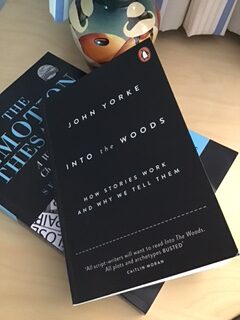Book Review: Into the Wood – Rubber Duckies, McGuffins, and The Kuleshov Effect
How do stories work and why do we tell them? These questions are given a logical and detailed analysis by John Yorke in his engaging and persuasive Into the Woods, which I discovered via fellow award-winning crime writer Liam McIlvanny at a Society of Authors event. It is one of the few books that having finished, I want to re-read again immediately – more slowly. Though aimed primarily at screen writers, it has much to inform authors (Ken Follett rated it ‘brilliant’) and to entertain readers who might wonder why they love certain kinds of stories.
Drawing on psychology, philosophy, and examples from myths, legends, the playwrights of ancient Greece through Shakespearean England to modern TV and films, he expands on the ideas of former story classifiers like Christopher Booker (The Seven Basic Plots) to show how most stories have a remarkably similar, symmetrical shape whether they are 3 or 5 act formats. He likens them to music with beats, citing how non-conformist stories can still be powerful if written by masters of the form who take elements and re-order them e.g., adding beats from a different bar, like in jazz. Indeed, he offers evidence drama has a similar effect on the brain to music.
Fascinating ‘trade’ concepts are explained, like the Kuleshov Effect, named after the Russian director who showed audiences can interpret the same actor’s expression variably as hunger, grief, or even love depending on an associated given image. It seems we all want to make sense of our world, to rationalise chaos, and to do so, form our own associations and interpretations of stories whether provided as audio, visual or written entertainment..
Most successful writers grasp they need a protagonist and antagonist as characters, an inciting incident after which they will be on a journey to the denouement ‘resolution’ via climaxes. I loved the idea of the ‘Rubber Ducky’ moment – the bit in the storyline where something (e.g., a letter or photo) is found that explains an earlier incident. The book is packed with suggestions for what heightens or dampens drama and quotes everything from Terence Rattigan plays to movies like Thelma and Louise. Yorke shows most ‘battles’ are over status, control or power and involve love, sadness or loss. The type of endings in favour have evolved over time. His postulated blueprint for drama draws on everything from Marlow’s Hierarchy of Needs to Jungian analysis and philosophers’ perspectives as he explains that, like us, characters need flaws, are repressed, seek enlightenment, and must grow and learn on their journey. Fascinatingly, he demonstrates that good drama comprises of ‘fractals.’ In the most effective stories, the micro pattern of each scene is reproduced in each act and mirrored in the overall work. Marlow and Nietzsche notwithstanding, Yorke explains authors need coherent beats and scenes and acts to satisfy an audience.
In 280 short pages plus fascinating appendices, notes and bibliography, Yorke’s basic premise is that individuals and society are continually adapting to new or unknown scenarios, learning, and making order from chaos. In a story, viewers or readers need a protagonist to empathise with, whose dilemma is understandable, who can be followed into the metaphorical ‘dark wood’ archetypal in myth and fairy tale, and from whom they can learn as the actors succeed against the odds. Series are popular since we already know the characters and can thus concentrate on their moral dilemmas and capacity to overcome repeated adversity. The protagonists are our flawed avatars, facing an inciting incident (the delightfully named McGuffin, as coined by Hitchcock) journeying to Crisis and Climax and Resolution. Stories speak to us, give us food for thought, inform us of other worlds and sometimes offer answers to life’s problems. Like music, we seek different tempos and style for our different moods. For me, Yorke’s most telling quote comes from inimitable journalist Alistair Cooke whose radio Letter from America I enjoyed in the fifties and sixties with my father. ‘Broadcasting is the control of suspense.’ Similarly with writers. As Yorke affirms, ‘Come in late and leave early.’
Into the Woods, John Yorke, Penguin, 2013, ISBN 978-0-141-97810-9
Author Bio: John Yorke is Visiting Professor of English Language and Literature at the University of Newcastle, the Managing Director of Company Pictures, and has been Head of the UK’s Channel 4 Drama and BBC Drama Production. He has a vast string of credits to his name from his early days story-lining BAFTA winning EastEnders, to the Archers, Life on Mars, Casualty and prestigious dramas like The White Queen and Wolf Hall. www.intothewoodsyorke.com

Leave a Reply
You must be logged in to post a comment.